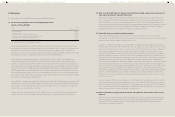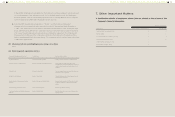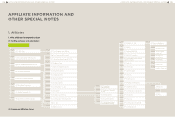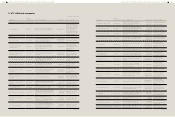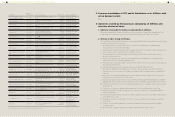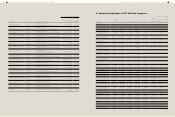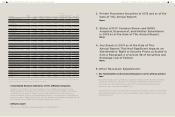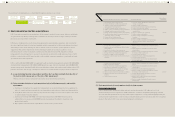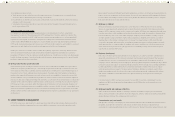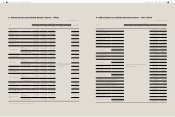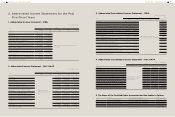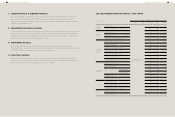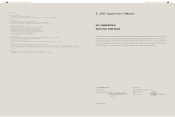HTC 2013 Annual Report Download - page 77
Download and view the complete annual report
Please find page 77 of the 2013 HTC annual report below. You can navigate through the pages in the report by either clicking on the pages listed below, or by using the keyword search tool below to find specific information within the annual report.
AFFILIATE INFORMATION AND OTHER SPECIAL NOTES AFFILIATE INFORMATION AND OTHER SPECIAL NOTES
150 151
The workflow for handheld devices, from R&D through production, is as follows:
2. Environmental protection expenditures
HTC Corporation manufactures smartphone. With regard to production processes, airborne pollutants
are generated only during soldering and solid wastes at various production stages. HTC's production
processes do not generate wastewater.
HTC places a high priority on effectively managing wastes generated by operations and consistently
allocates significant funds to install and maintain pollution prevention facilities and retain professional
staff. HTC provides offsite training for staff to acquire licenses needed to operate pollution control
equipment. HTC further implements internal training programs and conducts audits to ensure
relevant pollution control mechanisms operate properly and effectively. HTC regularly contracts
independent licensed inspectors to review its operational environment. Audit and inspections of HTC
facilities conducted since HTC was founded confirmed that company operations comply with relevant
government rules and regulations.
HTC is certified OHSAS18001:2007 occupational health and safety management system, ISO 14001:2004
environmental management, ISO 14064-1:2006 greenhouse gas emission standards and ISO50001:2011
energy management standard. Certification-mandated procedures and requirements further reduce HTC
pollution emissions and energy consumption and move us forward toward clean production objectives.
(1) Losses (including financial compensation) and fines due to pollution incidents from the start of
the most recent fiscal year and as of the date of this annual report:
HTC has not been fined or penalized for pollution by environmental authorities.
(2) Future strategies (inclusive of environmental protection facility improvements) and possible
expenditures:
a. Continue to strengthen the operations management on environmental protection equipment in
order to comply with government rules and regulations and reduce accidents and abnormalities;
b. Strengthen waste collection and recycling efforts. Encourage resource reuse as part of the effort
to achieve waste reduction targets;
c. Continue promoting ISO 14001 environmental management, ISO 14064-1 technical and
administrative measures and ISO50001 energy management standard to maximize clean
production benefits.
d. Major planned environmental expenditures over the next 2 years include:
Unit:NT$ thousands
Fiscal
Year
Item Anticipated Equipment Purchases / Expenditures Anticipated Benefits
Expenditures
(estimated)
2014
1. Headquarter campus greenification
2. Energy efficient air conditioning equipment
3. System to supply recycled wastewater as
landscaping & toilet flush water
4. Oil-water separator system construction
5. Water / power conservation promotion activities
6. Garbage reduction promotion activities
7. Energy efficient lighting system for new building
8. Drinking fountain power conservation function
and usage control on holidays
9. Energy efficient lighting system
10. Campus ecological pond construction
1. Promote campus greenification and reduce
energy consumption
2. Reduce energy consumption
3. Promote general waste reduction & recycling
4. Reduce environmental loading
5. Pantry, washroom, and bathroom efficient water
saving utilities
6. Recycle, separate type of garbage
7. Reduce energy consumption
8. Reduce energy consumption on drinking
fountains
9. Reduce energy consumption
10. Reduce energy consumption through campus
greening efforts to reduce carbon dioxide
emissions
131,550
2015
1. Energy efficient lighting system
2. Pantry, washroom, and bathroom efficient water
saving utilities
3. Inverters for elevators & air compressors
4. Water / power conservation promotion activities
5. Energy efficient air conditioning equipment
6. System to supply recycled wastewater
7. Rainwater collection tank construction to recycle
rainwater
1. Reduce energy consumption by using LED lighting
system
2. Pantry, washroom, and bathroom efficient water
saving utilities
3. Reduce energy consumption through the inverters
for elevators & air compressors
4. Conserve water resources
5. Energy efficient air conditioning equipment
6. Conserve water resources
7. Conserve water resources by recycling rainwater
for toilet flush water
11,250
2016
1. Energy efficient lighting system
2. Water conservation facilities
3. Energy efficient air conditioning equipment
4. Rnverters for elevators & air compressors
5. Waste water reprocess to provide for campus
watering system and ecological pond
6. Water / power conservation promotion activities
7. Garbage reduction and recycling promotion
activities
8. Campus greening efforts
1. Reduce energy consumption by using LED lighting
system
2. Pantry, washroom, and bathroom efficient water
saving utilities
3. Energy efficient air conditioning equipment
4. Reduce energy consumption through the inverters
for elevators & air compressors
5. Promote general waste reduction & recycling
6. Conserve water resources
7. Reduce waste volumes by promoting garbage
reduction and recycling
8. Reduce energy consumption through campus
greenification
125,700
(3) Environmental protection and employee health & safety measures
Environmental protection:
HTC is committed to operating healthy and safe work environments. HTC adheres to all local
environmental protection regulations. Cardboard boxes, containers and plastic packaging material
are collected and separated for recycling. HTC requires suppliers to comply with EU WEEE and RoHS
environmental requirements in order to reduce industrial waste, prevent pollution, and offer consumers
products that reflect HTC's low environmental impact commitment.
Setting Product
Specifications
Substrate
Manufacturing
Substrate
Testing
System
Assembly
Finished Product
Enters Warehouse
Software/
Hardware R&D
Finished Product
Testing & Inspection
Testing Certification


